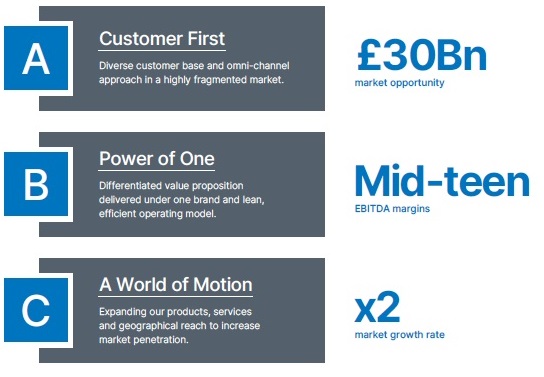We have set out our refreshed strategy to deliver mid-term market growth and value creation. Our strategy is based around three clear pillars:

A: Customer First
Our customer needs are changing, with increased digitisation across products and services. The need to operate machines and operations more sustainably drives increased adoption of electrification and opens up new opportunities such as one of industry’s megatrends, hydrogen. There is increased market consolidation happening and supply chains becoming more regionalised meaning strategic supplier partnerships are a critical enabler to drive customer satisfaction. With a shortage of skilled engineers in industry, this increases the demand on suppliers to move up the value chain to deliver complete solutions not only products.
B: The Power of One
Unlocking this potential is made possible by simplifying the operating model under one brand, Flowtech. In doing so, shifting from a fragmented house of brands to a leveraged and integrated branded house. This includes rebranding over ten ‘own branded’ product ranges into one, FT Pro, then to increase brand building activity around a simple and compelling customer value proposition. We put the building blocks in place in H2 2023 to enable this rebranding and transition to one Flowtech in H1 2024 including the launch of a new catalogue in April 2024 and the next generation Flowtech website landing during H2 of 2024.
The fluid power market is changing and we need to evolve to meet our customer needs and accelerate our commercial advantage. Expanding our product and service offering across the power, motion and control sectors increases our addressable market opportunity in Europe from £10bn to more than £30bn helping us to increase customer penetration and future proofing our business. Bringing together our full capabilities and potential under one brand, one simple operating model and one value proposition.
C: A World of Motion
Flowtech is well positioned to create competitive advantage by unlocking the full Group potential with a broad technical product offering and engineering service capability across our indirect distributor network and our direct channels. This includes a mature own brand product portfolio with the opportunity to continue to expand and grow its share. The mid-term opportunity is to expand our product and service offering into the wider ‘World of Motion’ to better support our collective customers and their evolving needs.
In doing so, increasing the existing fluid power market opportunity three-fold into the broader power, motion and control market (estimated at more than £30bn in Europe).
We have identified six EBITDA growth engines. These are:
- Customer growth – maximising opportunity in our current customer base and acquiring new customers
- Commercial excellence – ensuring we have a robust and clear commercial approach
- Product and service expansion – building out our offer to accelerate our market potential
- Own brand growth – offering an alternative product range, delivering excellent quality and great value
- Operate for less – maximising what we have and operating our business lean
- Talent and capability – investing in our people